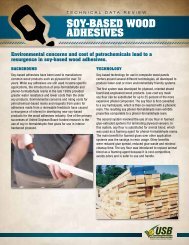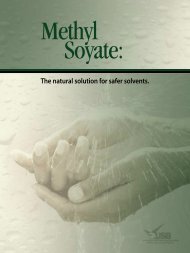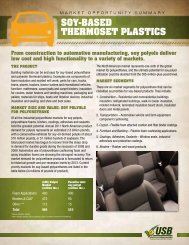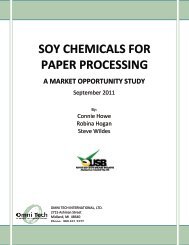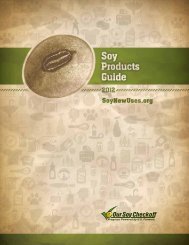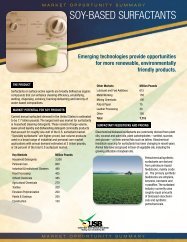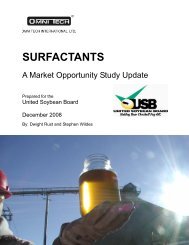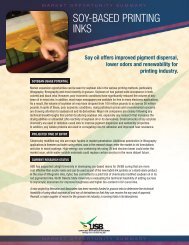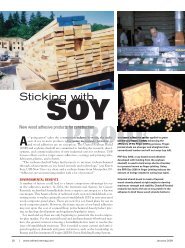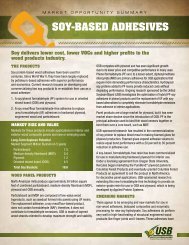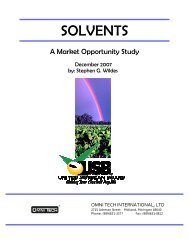Soy-Based Materials and Green Building ... - Soy New Uses
Soy-Based Materials and Green Building ... - Soy New Uses
Soy-Based Materials and Green Building ... - Soy New Uses
You also want an ePaper? Increase the reach of your titles
YUMPU automatically turns print PDFs into web optimized ePapers that Google loves.
www.soynewuses.org<br />
<strong>Soy</strong>-<strong>Based</strong> <strong>Materials</strong> <strong>and</strong><br />
<strong>Green</strong> <strong>Building</strong> Construction<br />
Technologies<br />
<strong>Soy</strong> materials for building construction are renewable,<br />
environmentally friendly <strong>and</strong> ideal for green building.<br />
Benefits as compared to petrochemical <strong>and</strong> other<br />
material stocks show a range of performance <strong>and</strong><br />
environmental benefits.<br />
<strong>Soy</strong> is a versatile plant, offering a range of uses in our society. Myriad<br />
food products are derived from soy protein. The use of soy-based ink<br />
has become a popular alternative to st<strong>and</strong>ard inks, in part because<br />
it is seen as safer, greener <strong>and</strong> healthier than traditional inks. Even<br />
more significant, building professionals can use soy-based products<br />
for building design <strong>and</strong> construction uses, as an alternative to other<br />
building materials made with petrochemicals.<br />
Interest in biobased construction materials is growing rapidly.<br />
Underst<strong>and</strong>ing the performance attributes of soy-based materials gives<br />
building teams a better underst<strong>and</strong>ing of how soy is used for a wide<br />
range of building products <strong>and</strong> construction-related applications.<br />
<strong>Green</strong> benefits of soy-based materials<br />
Among the most significant recent advances in building technology<br />
is the use of soy-derived building products as an alternative to<br />
petrochemical-based materials <strong>and</strong> finishes. Beyond soy ink, the<br />
products can be used in many areas of building <strong>and</strong> include adhesives,<br />
plastics, insulation, barriers, sealants <strong>and</strong> coatings. In addition, many<br />
lubricants <strong>and</strong> solvents used in building mechanical systems can be<br />
made with soy. Last, soy is increasingly used for biodiesel, which may<br />
be part of a building’s fuel mix.<br />
Life-Cycle Benefits of <strong>Soy</strong><br />
Rigorous studies of the impact of U.S. soybean<br />
applications demonstrate valuable life-cycle<br />
contributions by employing soy for non-food uses,<br />
including building construction materials.<br />
In 2010, the United <strong>Soy</strong>bean Board (USB) released<br />
a peer-reviewed update of the life-cycle inventory<br />
(LCI) databases for soybean production <strong>and</strong><br />
processing into four key soy-derived feedstocks for<br />
industrial products: (1) methyl soyate, (2) soy lube<br />
base stock, (3) soy polyol <strong>and</strong> (4) soy resin.<br />
continued<br />
soynewuses.org | 1
<strong>Soy</strong>-<strong>Based</strong> <strong>Materials</strong> <strong>and</strong> <strong>Green</strong> <strong>Building</strong> Construction Technologies<br />
Renewable resource. Because it is a food crop, is soy a<br />
limited resource for construction? Not at all. According to experts in<br />
agriculture <strong>and</strong> economics, soy is abundant <strong>and</strong> rapidly renewable<br />
– <strong>and</strong> a sensible alternative to limited petroleum-based <strong>and</strong> mineral<br />
products. Currently, production levels have reached about 20 billion<br />
pounds of crude soybean oil each year in the United States alone, a<br />
figure that increases each year. The global supply of refined vegetable<br />
oil is estimated at more than 140 million metric tons. <strong>New</strong> uses for<br />
construction materials <strong>and</strong> building are growing rapidly, but they are<br />
not a significant impact on the supply of soybean oil for food uses.<br />
Low toxicity. Construction materials produced from soy share<br />
another valuable benefit: a healthier profile than petroleum <strong>and</strong><br />
chemical substances. <strong>Soy</strong>-based products tend to be low in volatile<br />
organic compounds (VOCs), <strong>and</strong> soy helps replace materials with<br />
undesirable components such as urea-formaldehyde in wood products,<br />
ammonia (urea), methanol <strong>and</strong> the like.<br />
A good example is the growing use of soy adhesives in making plywood.<br />
These strong, effective adhesives are drop-in replacements for ureaformaldehyde<br />
adhesives, which emit (off-gas) formaldehyde into<br />
building indoor air; unhealthy concentrations of formaldehyde indoors<br />
can contribute to “sick building syndrome.” Due to its sustainable<br />
traits <strong>and</strong> association with healthy environments, soy plywood is<br />
increasingly used in such areas as wall construction, casework, flooring<br />
<strong>and</strong> furnishings.<br />
The use of soy-related products is competitive on cost, <strong>and</strong> the<br />
materials are widely available through lumber suppliers. With this<br />
success, similar soy adhesives are being developed for oriented str<strong>and</strong><br />
board (OSB), particleboard <strong>and</strong> medium-density fiberboard (MDF).<br />
Life-Cycle Benefits of <strong>Soy</strong><br />
continued<br />
The LCI’s cradle-to-gate scope – from soybean<br />
farming through product processing – found major<br />
greenhouse gas (GHG) reductions through soybean<br />
production, which scrubs carbon during the plant<br />
growth phase.<br />
• The release of nitrous oxide (N2O) was found<br />
to be 85 percent less than the current U.S. LCI<br />
Database shows.<br />
• About 20 percent less direct energy is needed<br />
for soybean farming today as compared to 1998<br />
levels, thanks to reduced diesel <strong>and</strong> gasoline usage.<br />
• Energy consumption for soybean processing<br />
has been reduced by 45 percent since 1998.<br />
• A life-cycle impact assessment (LCIA) in<br />
the USB study showed that all four soy-derived<br />
feedstocks significantly reduce greenhouse-gas<br />
emissions <strong>and</strong> fossil fuel use as compared to<br />
petroleum-based equivalents.<br />
The peer-reviewed USB life-cycle study presents<br />
further evidence of the energy <strong>and</strong> environmental<br />
benefits of U.S. soybean farming <strong>and</strong> processing.<br />
The results confirm why manufacturers are<br />
increasingly using soy for “green chemistry”<br />
to support a wide array of biobased products,<br />
including construction adhesives, sealants <strong>and</strong><br />
spray-foam insulation.<br />
soynewuses.org | 2
<strong>Soy</strong>-<strong>Based</strong> <strong>Materials</strong> <strong>and</strong> <strong>Green</strong> <strong>Building</strong> Construction Technologies<br />
Environmental contribution. Yet the primary benefit of soybased<br />
adhesives is that the products are inherently green. That’s<br />
true in green building use, but it is also the nature of the renewable<br />
resource itself. First, as soy plants grow, they remove greenhouse gases<br />
from the atmosphere; in the United States alone, the total cultivation<br />
of 3.36 billion bushels of soybeans in 2009 eliminated the carbon<br />
equivalent of 21 million automobiles.<br />
Second, as a renewable, low-toxicity resource that contributes to<br />
good indoor environmental quality (IEQ), soy materials contribute to<br />
meeting the requirements for the new International <strong>Green</strong> Construction<br />
Code (IGCC), ASHRAE’s St<strong>and</strong>ard 189.1, California’s state greenbuilding<br />
code Cal<strong>Green</strong> <strong>and</strong> the U.S. <strong>Green</strong> <strong>Building</strong> Council’s LEED<br />
certification system.<br />
Life-cycle studies show<br />
that all soy-derived<br />
feedstocks significantly<br />
reduce greenhouse-gas<br />
emissions <strong>and</strong> fossil<br />
fuel use as compared<br />
to petroleum-based<br />
equivalents.<br />
Third, in the LEED st<strong>and</strong>ards, for example, the use of soy-based<br />
materials can help achieve credits in a variety of categories, including<br />
<strong>Materials</strong> & Resources (MR), Indoor Environmental Quality (IEQ) <strong>and</strong>,<br />
in some cases, Innovation in Design. Beyond these, many soy-based<br />
products help meet criteria for the EPA’s Energy Star program, or the<br />
Cool Roof Rating Council’s database. In addition, a recent life-cycle<br />
inventory was conducted to help compare soy-derived feedstocks<br />
against their petrochemical equivalents, with very positive results (see<br />
“Life Cycle Benefits of <strong>Soy</strong>,” page 1).<br />
“U.S. soy already delivers environmental <strong>and</strong> energy benefits,” said<br />
John Cooper, a USB director <strong>and</strong> soybean farmer in Wynne, Arkansas.<br />
“It’s exciting to see the trends point to even more in the future.”<br />
soynewuses.org | 3
<strong>Soy</strong>-<strong>Based</strong> <strong>Materials</strong> <strong>and</strong> <strong>Green</strong> <strong>Building</strong> Construction Technologies<br />
Applications Uncover Advantages<br />
Recent projects using soy-derived materials include the four-story<br />
headquarters for Heifer International in Little Rock, Arkansas. The<br />
semicircular office building, designed as a durable, 100-year structure,<br />
targeted a 55 percent energy reduction as compared to comparable<br />
structures. <strong>Materials</strong> included a soy-based spray foam for insulation <strong>and</strong><br />
barrier protection. The project earned platinum certification under LEED-<br />
NC, <strong>and</strong> was selected by the American Institute of Architects (AIA) as a<br />
Top Ten <strong>Green</strong> Project by the AIA Committee on the Environment.<br />
In another example, a building team used wood adhesives that<br />
include soybean meal. For a military office project in Virginia, Fort<br />
Lee’s <strong>Building</strong> 11108, the cabinets built <strong>and</strong> installed throughout<br />
the building emit no formaldehyde. They are made with a hardwood<br />
plywood manufactured with a soy-based, formaldehyde-free adhesive.<br />
The 15,000-square-foot, single-story building now has about 25<br />
cabinet units scattered through seven locations in the facility. All of<br />
these cabinets are constructed with the zero-formaldehyde products,<br />
removing a known human carcinogen that can cause eye, nose <strong>and</strong><br />
throat irritation as well as respiratory problems, according to the U.S.<br />
Environmental Protection Agency (EPA).<br />
CASE STUDY<br />
Meeting Formaldehyde<br />
Rules with <strong>Soy</strong>-<strong>Based</strong><br />
Wood<br />
Recent federal rules limiting formaldehyde<br />
emissions from pressed wood products have led<br />
to more use of soy-based wood adhesives.<br />
In response, companies, including Columbia Forest<br />
Products, have developed formaldehyde-free<br />
plywood technologies.<br />
According to the United <strong>Soy</strong>bean Board, “Using<br />
soy-based adhesives <strong>and</strong> other biobased products<br />
reduces reliance on foreign petrochemicals <strong>and</strong><br />
can help improve the environment by reducing VOC<br />
emissions.” Wood panels using soy adhesives also<br />
perform well, displaying better water resistance<br />
than formaldehyde plywood with equal or better<br />
strength <strong>and</strong> durability, according to Columbia<br />
Forest Products.<br />
To make the panels, the company uses about<br />
15 million pounds of flour processed from U.S.<br />
soybeans annually. <strong>Soy</strong> flour is a rapidly renewable<br />
resource, <strong>and</strong> its use in manufacturing architectural<br />
<strong>and</strong> construction products is growing, according to<br />
the United <strong>Soy</strong>bean Board.<br />
soynewuses.org | 4
<strong>Soy</strong>-<strong>Based</strong> <strong>Materials</strong> <strong>and</strong> <strong>Green</strong> <strong>Building</strong> Construction Technologies<br />
Current Use of <strong>Soy</strong> <strong>Materials</strong> in Construction<br />
Increasingly, these examples of green building are becoming not the<br />
exception, but rather the rule. Methods <strong>and</strong> materials are becoming<br />
more abundant for applying soy-derived products in construction<br />
techniques, some with multiple advantages over conventional<br />
approaches. Highlights of the product universe include<br />
1 <strong>Soy</strong>bean oil in adhesives, coatings, solvents <strong>and</strong><br />
the like. Similar to linseed oil, soy oils have good drying properties<br />
<strong>and</strong> are valuable for making alkyd resins for inks, paints <strong>and</strong> industrial<br />
coatings. In recent years, however, soybean oil has shown promise<br />
in waterborne paints <strong>and</strong> architectural coatings. One manufacturer,<br />
Sherwin-Williams, uses hybrid soy resins for a line of sustainable<br />
interior paints; another, Rust-Oleum, offers a line of soy-based<br />
wood stains. In addition, a new generation of metal coatings, “cool<br />
roof” coatings, <strong>and</strong> concrete stains <strong>and</strong> sealers – all based on soy<br />
technologies – bring the market low-VOC, renewable product choices.<br />
2 Plywood, <strong>and</strong> molded pre-engineered wood. <strong>Soy</strong><br />
adhesives offer numerous properties that make them ideal for creating<br />
wood panels <strong>and</strong> structural timber composites. First, the adhesives’<br />
resistance to heat <strong>and</strong> fire makes them valuable as a binder for<br />
particleboard <strong>and</strong> fiberboard, but also in structural joints for wood<br />
beams, joists <strong>and</strong> any assembly joinery. Second, they tend to be lighter<br />
than conventional manufactured wood products. Third, the products<br />
share the benefits of using soy as a base material: zero formaldehyde,<br />
low VOCs <strong>and</strong> a renewable base resource. Several manufacturers have<br />
introduced products with soy-based urethanes <strong>and</strong> other adhesives as a<br />
substitute for petrochemical-based polyols. Wood composites with soybased<br />
adhesives help eliminate phenols, ureas <strong>and</strong> formaldehyde that<br />
come from natural gas <strong>and</strong> petroleum.<br />
CASE STUDY<br />
Paints with <strong>Soy</strong><br />
Components Reduce<br />
VOC Levels<br />
The desire for safer <strong>and</strong> more sustainable<br />
chemicals, processes <strong>and</strong> products for building<br />
construction has led to increased attention on the<br />
benefits of soy in coatings <strong>and</strong> sealants.<br />
Companies are developing new paints <strong>and</strong> stains<br />
using soybean oils, including a new water-based<br />
acrylic alkyd paint by Sherwin-Williams made<br />
with soy oil <strong>and</strong> recycled plastic bottles (PET).<br />
The resulting formula reduce volatile organic<br />
compounds (VOCs) by 60 percent, says<br />
the company.<br />
<strong>Soy</strong>bean oil promotes film formation, gloss, flexibility<br />
<strong>and</strong> cure. The soy-based paint formulations<br />
are shown to dry quickly “with less yellowing<br />
<strong>and</strong> improved shelf life with water cleanup” as<br />
compared to other paints, say industrial experts.<br />
continued<br />
soynewuses.org | 5
<strong>Soy</strong>-<strong>Based</strong> <strong>Materials</strong> <strong>and</strong> <strong>Green</strong> <strong>Building</strong> Construction Technologies<br />
3 Use in roofing shingles. <strong>Soy</strong> has also been introduced as<br />
a base material for producing an alternative to asphalt cement, which<br />
constitutes about 28 percent of the materials for roof shingles. Some<br />
manufacturers <strong>and</strong> contractors are recycling used shingles, a valuable<br />
material reuse strategy, using solvents that are about 25 percent soy<br />
based. The reduced asphaltic content is considered a promising way to<br />
cut project costs, as primary asphalt prices have quadrupled in the last<br />
decade alone.<br />
4 A world of alternative plastics. One of the most promising<br />
areas of development is the use of soy-derived materials in creating<br />
strong, beneficial construction plastics. Four areas are worthy of focus:<br />
spray foams, carpet backing, soy foams for furniture <strong>and</strong> high-density soy<br />
foams for decorative materials. In all cases, soy offers an alternative to<br />
petrochemical components, which are limited resources that historically<br />
rise in cost. <strong>Soy</strong> polyols can be used for polyurethane <strong>and</strong> as a base<br />
material for thermoset plastics, such as composites. Performance factors<br />
such as weight, strength <strong>and</strong> durability are equivalent, <strong>and</strong> the cost of<br />
the soy-based products is trending downward.<br />
CASE STUDY<br />
Paints with <strong>Soy</strong><br />
Components Reduce<br />
VOC Levels<br />
Using 320,000 pounds of soybean oil in conjunction<br />
with 250,000 pounds of PET allowed the<br />
manufacturer to offset more than 800,000 pounds of<br />
VOCs, solvents <strong>and</strong> other petroleum-based feedstock.<br />
Recognizing the benefits to building occupants, last<br />
year the U.S. Environmental Protection Agency gave<br />
the product developers a 2011 Presidential <strong>Green</strong><br />
Chemistry Award.<br />
• Polyurethane-based products based on soy polyols include carpet<br />
backing <strong>and</strong> backing for outdoor carpet <strong>and</strong> artificial turf. The soy<br />
feedstocks replace styrene butadiene <strong>and</strong> polyvinyl chloride (PVC)<br />
backings, reducing not only VOC production but also the total<br />
flammability of the flooring.<br />
soynewuses.org | 6
<strong>Soy</strong>-<strong>Based</strong> <strong>Materials</strong> <strong>and</strong> <strong>Green</strong> <strong>Building</strong> Construction Technologies<br />
• Spray-foam insulation based on soy plastics made <strong>and</strong> installed by<br />
several manufacturers delivers a high R-value <strong>and</strong> a good barrier<br />
for air <strong>and</strong> moisture. The product is typically applied as a system,<br />
sprayed into enclosures, on roofs, or into floor <strong>and</strong> roof assemblies.<br />
• For furnishings, built-in seating <strong>and</strong> other uses, flexible soy foam<br />
enjoys a growing market in the architectural <strong>and</strong> construction<br />
industry. It is already used extensively in the automotive <strong>and</strong><br />
furniture industries.<br />
• Last, soy plastics technology is employed for high-density, rigid<br />
molded foams that can substitute for molded polyurethane<br />
products. These are used as insulation or as decorative trims,<br />
panels <strong>and</strong> accessories.<br />
5 Other building products <strong>and</strong> materials. These include soy<br />
solvents now used in product manufacture, which will in the future<br />
also be a more commonly specified items or contractor products. <strong>Soy</strong><br />
solvents offer reduced ozone depletion potential (ODP) as compared<br />
to conventional petroleum-based solvents, <strong>and</strong> they are considered<br />
nonhazardous. At this time, the building team can ask for soy solvents,<br />
soy adhesives <strong>and</strong> other soy-based materials as an alternate specification.<br />
One of the most promising<br />
areas of development is<br />
the use of soy-derived<br />
materials in creating<br />
strong, beneficial<br />
construction plastics.<br />
soynewuses.org | 7
<strong>Soy</strong>-<strong>Based</strong> <strong>Materials</strong> <strong>and</strong> <strong>Green</strong> <strong>Building</strong> Construction Technologies<br />
The <strong>Green</strong> Benefits of <strong>Soy</strong> in <strong>Building</strong><br />
While the myriad product offerings using established, effective soybased<br />
material technologies make them increasingly attractive to<br />
building teams, there are other market drivers. Most important are<br />
the contributions to green building <strong>and</strong> sustainable design techniques.<br />
For soy-based adhesives, for example, a life-cycle analysis reveals<br />
a variety of environmental benefits along the supply chain. <strong>Soy</strong><br />
solvents offer reduced ODP <strong>and</strong> other benefits as a “nonhazardous<br />
product” specification.<br />
The USGBC’s LEED certification system can reward the use of soyderived<br />
base materials, including finished products <strong>and</strong> base materials<br />
such as resins <strong>and</strong> solvents, in its <strong>Materials</strong> <strong>and</strong> Resources (MR)<br />
section, which seeks to “transform material use <strong>and</strong> disposal through<br />
the use of products, materials <strong>and</strong> processes that possess attributes<br />
associated with lower environmental impacts.” <strong>Soy</strong> does that on a<br />
number of levels, with life-cycle impact assessments for four major<br />
soy-based feedstocks significantly reducing greenhouse gas emissions<br />
<strong>and</strong> using less fossil fuel in their manufacture. Other benefits of soy for<br />
achieving MR credits include:<br />
• Use of a rapidly renewable resource.<br />
• Avoiding chemicals of concern.<br />
The USGBC’s LEED<br />
certification system<br />
can reward the use<br />
of soy-derived base<br />
materials, including<br />
finished products <strong>and</strong><br />
base materials such as<br />
resins <strong>and</strong> solvents<br />
• Good life-cycle assessment (LCA) scores.<br />
A second credit area that benefits from soy-based materials is the<br />
Indoor Environmental Quality (IEQ) category, which “promotes strategies<br />
that improve indoor air as well as those that provide access to natural<br />
daylight <strong>and</strong> views <strong>and</strong> improve acoustics.” Here as well, soy can help<br />
with such credits as IEQ 4.1, which establishes thresholds for material<br />
emissions <strong>and</strong> VOC levels, as well as 4.4, which rewards the use of wood<br />
products that don’t have added urea-formaldehyde. In these <strong>and</strong> other<br />
credits, soy contributes to better IEQ – <strong>and</strong> higher certification levels.<br />
soynewuses.org | 8
<strong>Soy</strong>-<strong>Based</strong> <strong>Materials</strong> <strong>and</strong> <strong>Green</strong> <strong>Building</strong> Construction Technologies<br />
More Benefits for the <strong>Building</strong> Team<br />
The advantages of using soy-based materials <strong>and</strong> finishes go far<br />
beyond LEED certification, although the ratings are a major market<br />
driver. For example, interest in improved indoor air quality (IAQ) <strong>and</strong><br />
reduced use of “chemicals of concern” <strong>and</strong> material offgassing have<br />
prompted the adoption of more soy-based compounds useful in making<br />
architectural paints. In some cases, soy oil is an additive to existing<br />
latex formulations, reducing VOC levels, or it is the foundation for a<br />
completely novel polymer formulation.<br />
The increased us of Health Product Declarations (HPDs) for building<br />
materials will also benefit soy-derived oils, adhesives as well as resins<br />
<strong>and</strong> plastics. Similar to environmental product declarations (EPDs),<br />
which describe the life-cycle environmental characteristics of products,<br />
HPDs describe not just the product’s material makeup but also how<br />
base materials impact human health. With reduced VOCs <strong>and</strong> toxicity<br />
levels, soy-derived materials will grow with increased interest in HPDs.<br />
A second area that bodes well for soy is the quantifying of building<br />
performance. In many cases, the soy specification provides equivalent<br />
or enhanced performance of the life of the building. <strong>Soy</strong>-based<br />
waterborne latex paints, for example, have been tested to deliver<br />
high-performance sealing <strong>and</strong> reduced deterioration as compared to<br />
commonly used latex coatings. Improvements have been reported<br />
recently in hydrolytic stability (shelf life) <strong>and</strong> yellowing, as well as ease<br />
of application, speed of finished product drying, <strong>and</strong> cleanup. The<br />
products are cost-competitive <strong>and</strong> abundant, <strong>and</strong> deliver the lowest<br />
possible VOC levels in the category. In terms of use <strong>and</strong> application,<br />
contractors note they are no different from traditional latex paints.<br />
In some cases, the soy-based materials deliver increased strength<br />
<strong>and</strong> even new attributes that allow for greater design freedom.<br />
Biobased composites, for example, are shown to provide very good<br />
heat resistance, as well as high strength <strong>and</strong> adhesion capacities. The<br />
composites are also very lightweight, <strong>and</strong> can be molded into complex<br />
shapes during the manufacturing or construction process.<br />
soynewuses.org | 9
<strong>Soy</strong>-<strong>Based</strong> <strong>Materials</strong> <strong>and</strong> <strong>Green</strong> <strong>Building</strong> Construction Technologies<br />
Similar benefits have been noted for soy-based thermoset plastics,<br />
made with either soy oil <strong>and</strong> fiberglass or soy meal <strong>and</strong> natural fibers.<br />
<strong>Soy</strong> oil is used in making unsaturated polyester resins, which are used<br />
to make molded composites like tub <strong>and</strong> shower surrounds. <strong>Soy</strong> meal<br />
combined with natural fibers such as wood, kenaf <strong>and</strong> jute produces a<br />
lightweight, engineered composite for molding into a variety of shapes,<br />
such as corrugated panels, that can be cut <strong>and</strong> shaped like wood with<br />
excellent screw-holding properties.<br />
The testing of structural engineered wood using soy adhesives is<br />
another success story. <strong>Soy</strong>-derived adhesives have been found to offer<br />
superior heat resistance, prolonging the structural integrity of the wood<br />
structure in a fire, <strong>and</strong> soy proteins are serve as a robust binder in<br />
renewable, plant-fiber composite particleboard <strong>and</strong> MDF. The products<br />
have a high strength-to-weight ratio <strong>and</strong> – like all soy-based materials –<br />
are completely formaldehyde-free.<br />
Best of all, novel <strong>and</strong> established soy-related building materials have<br />
been shown to be cost effective <strong>and</strong> even compete in price with most<br />
available materials. In some cases, a slight price premium is offset<br />
by the clear benefits to improved occupant health <strong>and</strong> green building<br />
st<strong>and</strong>ards. Most important, the prices tend to be stable in spite of<br />
commodity price fluctuations, for example for soy flour. The reason is<br />
simple: An abundant, rapidly renewable resource, soy is long on supply<br />
<strong>and</strong> a stable market for the long term.<br />
The simple soybean<br />
sounds like a winning<br />
ingredient – ripe for<br />
growth in the world<br />
of building design<br />
<strong>and</strong> construction.<br />
An abundant, renewable resource that is healthier for building<br />
occupants <strong>and</strong> versatile <strong>and</strong> durable for construction uses? The simple<br />
soybean sounds like a winning ingredient – ripe for growth in the world<br />
of building design <strong>and</strong> construction.<br />
soynewuses.org | 10



